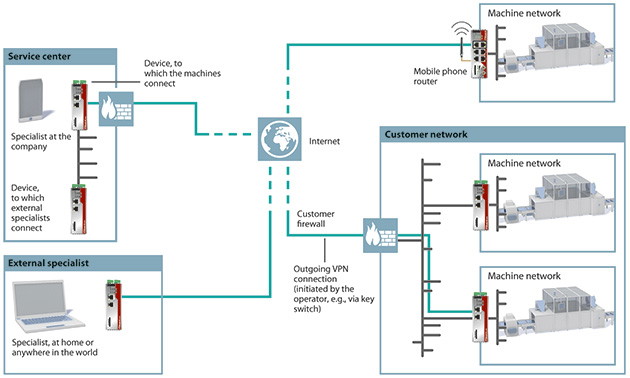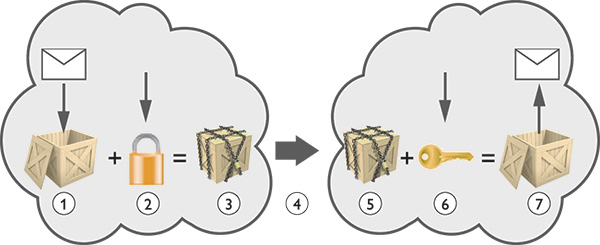The Internet of Things (IoT) and Industry 4.0 have had a significant impact on the commercial world. People want everything connected so they can make smart decisions. For example, sensors around homes can communicate to thermostats to determine and adjust temperature.
These themes have extended to the industrial world and can provide similar efficiency when implementing intelligent pumping systems. IoT is slowly becoming the norm within the industrial world and is changing the needs of end users. These changes must be addressed and adopted by original equipment manufacturers (OEMs) and system integrators.
IoT provides higher system reliability and reduced maintenance costs to service providers. This can translate into a more complete offering for the end user. Remote monitoring and intelligent devices can create a measurable competitive advantage.
Communication between systems can greatly improve the control and monitoring of applications in many ways. As new technologies interact with different media and networks, however, security must always be a consideration. In a globally connected world in which many systems rely on public methods for communication, such as the Internet, protecting networks from exterior and interior threats is critical.
This article discusses three important factors regarding IoT connected systems that end users should consider:
- How the systems help pump end users
- The advantages and disadvantages of several communication technologies, wired and wireless
- Security considerations to keep in mind when using these methods
1. IoT Benefits
Many applications in the pumping industry can implement IoT ideas. Long gone are the days when all the control decisions were made directly at the main control station. When quick decisions are necessary, the ability to remotely control and communicate information efficiently can make the difference in managing critical situations, such as stormwater management. By having sensors communicate the rapid increase of flow water into drainage systems, an operator can quickly inform valves and divert flow to underwater caves to avoid overflow of sewage water into rivers.
Remote maintenance on specialized machinery can also be implemented via IoT arrangements to reduce travel and maintenance costs. By remotely communicating with these systems, an OEM can improve end users' repair contracts by remotely connecting to machinery to obtain valuable data on the status of these machines. System availability and lower shutdown times are a direct effect of using remote maintenance technologies. Alarms sent to a plant operator using text messages when a pump fails can make the difference in determining and preventing tank overflow. A plant operator or manager can easily access that pump and determine the best course of action to address the concern.
 Figure 1. As the IoT moves into the industrial world, remote maintenance will help reduce travel and maintenance costs. (Graphics courtesy of Phoenix Contact)
Figure 1. As the IoT moves into the industrial world, remote maintenance will help reduce travel and maintenance costs. (Graphics courtesy of Phoenix Contact)2. Communication Systems
Many options are available to communicate with equipment within a plant or other facility. This section details several system types and their advantages and disadvantages.
Wired Ethernet Systems
In most of the U.S., having an Internet connection has become a commodity. Most homes and offices enjoy the comfort of high-speed Internet connections. This network option is slowly becoming available on the plant floor. More engineers are demanding that their IT departments provide a solution for remote maintenance or for supervisory control and data acquisition (SCADA) monitoring. A wired Ethernet connection is the physical connection to a port that leads to the public Internet.
 Figure 2. Security measures, such as encryption and the installation of firewalls, ensure that data arrives safely in the proper destination. Certificates provide keys and locks to add a layer of security to data.
Figure 2. Security measures, such as encryption and the installation of firewalls, ensure that data arrives safely in the proper destination. Certificates provide keys and locks to add a layer of security to data. Some of the advantages of wired systems are:
- This method of communication provides system reliability. When using a physical wired connection, end users depend on a network infrastructure that has been in place for many years.
- The lack of data restrictions is also a strong asset. Physical wired connections don't restrict the amount of data a particular application can use. This makes wired Ethernet a popular technology for camera systems or other high-data transfer applications.
Some disadvantages are:
- Bandwidth scalability can be a drawback of this system. Obtaining a bigger pipeline for faster data speeds may require building additional infrastructure. This can be costly, and the Internet provider may translate these charges to the facility or end user, depending on the location.
- Availability can be troublesome. Many pumping stations in remote locations do not have a physical infrastructure built for communicating with the site. Leased lines have been a popular solution, but they are costly to maintain and most service providers are planning to discontinue them.
Proprietary Radio Systems
Proprietary wireless systems are another strong method for communicating with multiple sites. A wireless local area network (WLAN) is a wireless Ethernet connection between different devices in close proximity. The encryption of over-the-air transmissions is typically supported by industrial WLAN radios.
Some advantages are:
- WLAN can provide the scalability of a wired Ethernet system by expanding the physical network connection to a WLAN. Advances in WLAN technologies allow for high data rates by using 802.11n for high-speed data applications.
- Wireless can also reduce the cost of installation and the raw materials needed to provide communication between two points.
Disadvantages of these networks are:
- Network interference can become a problem when transmitting data. Many devices produce radio frequency signals that may be in the same frequency range as a WLAN radio. This can lead to a network slowdown. Adjusting the radio to different frequencies and testing for best throughput can help.
- WLAN radios can only communicate across a limited distance. When building a network, a site survey must be performed to determine the signal strength and availability. This will, in turn, provide a facility owner/operator with a more concrete idea of what the data rates will be.
Wireless Cellular Systems
As with wired systems, cellular systems are becoming a major source of Internet connection. Especially in the U.S., the build-up of infrastructure to support cellular systems has been rapid. A physical Ethernet connection is not always possible to reach the Internet. Cellular systems are also becoming the preferred method of a solution for service providers. Leased lines have been a popular way to gain access to remote sites. Network providers with supported leased lines are discontinuing the service or making it extremely expensive to encourage customers to migrate to cellular.
The advantages of these systems include:
- Cellular networks provide the highest connection availability. When using cellular systems, telecom towers provide the connection to the station. By using a cellular radio, end users can essentially take advantage of an already built wireless network so that the data can travel long distances.
- Bandwidth is a great advantage of this technology. Depending on the cost of the radio, it can be upgraded to Long-Term Evolution (LTE), which can provide high data rates comparable to a home Internet connection. These come at a premium. However, the availability of this technology gives end users a choice.
Some disadvantages are:
- Data restrictions now become a higher priority. In wired and proprietary wireless technologies, no price penalty for data overuse exists. In cellular networks, data plans must be purchased with the amount of data needed, with higher charges for higher data amounts. This is an important consideration because overage charges can be costly.
- Many operators still question the reliability of cellular technology for critical operations. The cellular networks are not as stable as a physical, wired connection. Because of this, a wireless, \uc0\u8232 cellular system will not be preferred for control of critical operations.
3. Security
The Internet can be a great tool to network multiple pumps or machinery for an application. However, its use allows traffic to leave the comfort of a personal or facility's network and enter the public domain. Many industries, such as power generation, have already implemented standards and regulations to protect networks from threats. Security has been and remains a big topic that will surely make its way into future standards implemented across the industrial world.
When working with Ethernet systems, security must always be considered, especially with any communication that leaves a facility's LAN.
Using virtual private network (VPN) technology to encrypt information must be a priority when deploying communication systems. An industrial security device with routing, VPN and firewall capabilities can provide many features to protect a network. A few recommendations for increasing an Ethernet system's security are listed below:
- Firewalls keep unwanted traffic from entering the network. With firewalls, end users can determine which Internet Protocol (IP) addresses, ports and media access control (MAC) addresses can communicate with a facility's internal networks. This restricts the amount and type of traffic that can enter the network. Firewalls also segregate internal networks and keep an industrial network separate from or restricted from an office network.
- Routing is a powerful tool that can help maintain a reliable Internet connection. Routers learn external networks so that they better understand what the best paths of communication are between different points. This router education ensures quicker and more stable communication. They can also help segregate networks and provide enhanced security.
- VPN technology can be used to encrypt data. When accessing the public network, traffic flows through multiple routers before reaching its destination. This traffic is visible to anyone listening on the line. If traffic is not encrypted, a packet can be easily intercepted and changed, which can cause high security problems. The use of certificates adds a higher level of security by implementing a safe exchange of keys to encrypt and decrypt messages.
Conclusion
IoT is an important tool that is strongly impacting the industrial world. SCADA and remote maintenance applications can provide real value and cost savings that can result in a competitive advantage, and many different technologies can help existing network systems increase performance.
Wired and wireless Ethernet systems are always improving to provide end users with better technologies for the future.
As IoT continues to transform industry, end users must always consider security when dealing with the Internet.
Routers and firewalls, which provide additional security benefits, will likely become a requirement by end users and facility owners.


